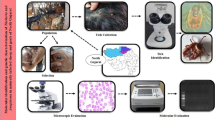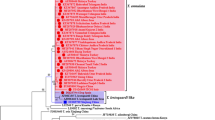Abstract
The phylogenetic relationships between six isolates of Theileria spp. infective to small ruminants, and two isolates of Theileria spp. infective to yak, all transmitted by Haemaphysalis qinghaiensis, together with the Theileria orientalis/sergenti/buffeli group and T. sinensis, were analyzed using the 18S ssrRNA gene sequence. The target DNA segment was amplified by polymerase chain reaction (PCR). The PCR product was used either for direct sequencing or was ligated to the PCR II vector for sequencing. The length of the 18S ssrRNA gene of all Theileria spp. involved in this study was around 1,740 bp. Two phylogenetic trees were inferred based on the 18S ssrRNA gene sequence of the Chinese isolates only, and Chinese isolates and other species of Theileria available in GenBank. In the first tree, the Theileria sp. infective to yaks was found to be T. sinensis. The Theileria sp. infective to small ruminants was found to be composed of two separate species of Theileria. Theileria sp. from Qinghai, Madang, Ningxian and Lintan, which was identical to the unidentified Theileria sp. described previously, is designated Theileria sp (China 1). The Theileria sp. from Longde, Zhangjiachuan and Lintan, which has not been described previously, is designated Theileria sp. (China 2) in order to avoid confusion. In the second tree, Theileria sp. (China 1) was closely related to benign Theileria, such as T. buffeli and T. sergenti, while Theileria sp. (China 2) was separated from other Theileria spp. The results indicate that H. qinghaiensis transmit at least three species of Theileria, two which are infective to sheep and goats, but not yak and one which is infective to yaks and cattle, but not to sheep and goats.




Similar content being viewed by others
References
Alani AJ, Herbert IV (1988) Morphology and transmission of Theileria recondita (Theileriidae: sporozoa) isolated from Haemaphysalis punctata from north Wales. Vet Parasitol 28:283–291
Allsopp BA, Bails HA, Allsopp MT, Cavalier-Smith T, Bishop RP, Carrington DM, Shrapnel B, Spooner P (1993) Discrimination between six species of Theileria using oligonucleotide probes which detect small subunit ribosomal RNA sequences. Parasitology 107 (Pt 2): 157–165
Allsopp MTEP, Cavalier-Smith T, De Waal DT, Allsopp BA (1994) Phylogeny and evolution of the piroplasms. Parasitology 108:147–152
Bai Q, Liu GY, Han GF (1995) An unidentified Theileria sp. infective to cattle in China (in Chinese). Chin J Vet Sci 15:16–21
Bai Q, Liu GY, Yin H, Zhao QZ, Liu DK, Ren JX, Li X (2002a) Theileria sinensis sp. nov.: study on classical taxonomy (in Chinese). Acta Anim Husb Vet Sci 33:73–77
Bai Q, Liu GY, Yin H, Zhao QZ, Liu DK, Ren JX, Li X (2002b) Theileria sinensis nov: study on molecular taxonomy (in Chinese). Acta Anim Husb Vet Sci 33:185–190
Barnett SF (1977) Theileria. In: Kreier JP (ed) Parasitic protozoa, vol 4. Academic Press, New York, pp 77–113
Barta JR (1989) Phylogenetic analysis of the class sporozoea (Phylum Apicomplexa Levine, 1970): evidence for the independent evolution of heteroxenous life cycles. J Parasitol 75:195–260
Barta JR (2001) Molecular approaches for inferring evolutionary relationship among protistan parasites. Vet Parasitol 101:175–186
Chae J, Lee J, Kwon O, Holman PJ, Waghela SD, Wagner GG (1998) Nucleotide sequence heterogeneity in the small subunit ribosomal RNA gene variable (V4) region among and within geographic isolates of Theileria from cattle, elk and white-tailed deer. Vet Parasitol 75:41–52
Chansiri K, Kawazu S, Kamio T, Terada Y, Fujisaki T, Philippe H, Sarataphan N (1999) Molecular phylogenetic studies on Theileria parasites based on small subunit ribosomal RNA gene sequences. Vet Parasitol 83:99–105
Ellis J, Hefford C, Baverstock PR, Dalrymple BP, Johnson AM (1992) Ribosomal DNA sequence comparison of Babesia and Theileria. Mol Biochem Parasitol 54:87–95
Friedhoff KT (1997) Tick-borne diseases of sheep and goats caused by Babesia, Theileria or Anaplasma spp. Parassitologia 39:99–109
Gubbels MJ, Yin H, van der Weide M, Qi B, Nijman IJ, Guangyuan L, Jongejan F (2000) Molecular characterization of the Theileria buffeli/orientalis group. Int J Parasitol 30:943–952
Gubbels MJ, Yin H, Q Bai, Liu GY, Nijman IJ, Jongejan F (2002) The phylonetic position of the Theileria buffeli group in relation to other species. Parasitol Res 88:S28–32
Irvin AD (1987) Characterization of species and strain of Theileria. Adv Parasitol 26:145–197
Irvin AD, Morrison WI (1987) Immunopathology, immunology and immunoprophylaxis of Theileria infections. In: Soulsby EL (ed) Immune responses in parasitic infections: immunology, immunopathology and immunoprophylaxis. Protozoa, vol III. CRC Press, Boca Raton pp 223–274
Kakuda T, Shiki M, Kubota S, Sugimoto C, Brown WC, Kosum C, Nopporn S, Onuma (1998) Phylogeny of benign Theileria species from cattle in Thailand, China and USA based on the major piroplasm surface protein and small subunit ribosomal RNA gene. Int J Parasitol 28:1261–1267
Katzer F, McKellar S, Kirvar E, Shiels B (1998) Phylogenetic analysis of Theileria and Babesia equi in relation to the establishment of parasite populations within novel host species and the development of diagnostic tests. Mol Biochem Parasitol 95:33–44
Kawazu S, Kamio T, Kakuda T, Terada Y, Sugimoto C, Fujisaki K (1999) Phylogenetic relationships of the benign Theileria species in cattle and Asian buffalo based on the major piroplasm surface protein (p33/34) gene sequence. Int J Parasitol 29:613–618
Li ZM, Hao YK, Chen TH, Yu XQ Xi HL, Zuo YR, Chen YQ Liu J, Ding YT, Meng ZX (1984) A report on sheep and goats in Dian’an community in Longde county (in Chinese). Gansu J Vet Anim Husb 1:13–14
Lu WS (1996) Theileriidae In: Zhao HY (ed) Parasitic diseases of livestock and control. Jilin Scientific and Technological Press, Changchun, pp 117–125
Luo JX, Yin H (1997) Theileriosis of sheep and goats in China. Trop Anim Health Prod 29:8S–10S
Luo JX, Yin H, Zhang QC, Lu Ws, Lu WS, Wang YY (1998) Isolation and observation of pathogenecity of Theileria infective to sheep (in Chinese). Chin J Vet Sci Technol 28:34–35
Mehlhorn H, Schein E, Ahmed JS (1994) Theileria. In: Kreier JP (ed) Parasitic protozoa, vol 7. Academic Press, London, pp 217–304
Morel PC, Uilenberg G (1981) Sur la nomenclature de quelque Theileria (Sporozoa, Babesioidea) des ruminants domestiques. Rev Elev Med Vet Pays Trop 34:139–145
Qinghai Veterinary and Animal Husbandry Research Institute (1968) Diagnosis of theileriosis of goats (in Chinese). Ann Qinghai Vet Anim Husb Res Inst 5:273–276
Schnittger L, Yin H, Jianxun L, Ludwig W, Shayan P, Rahbari S, Voss-Holtmann A, Ahmed JS (2000) Ribosomal small-subunit RNA gene-sequence analysis of Theileria lestoquardi and a Theileria species highly pathogenic for small ruminants in China. Parasitol Res 86:352–358
Stewart NP, Uilenberg G, De Vos AJ (1996) Review of Australian species of Theileria, with special reference to Theileria buffeli of cattle. Trop Anim Prod 28:81–90
Uilenberg G (1981) Theileria species of domestic livestock. In: Irvin AD, Cunningham MP, Young AS (eds), Advances in the control of theileriosis. Martinus Nijhoff, The Hague, pp 4–37
Uilenberg G, Perie NM, Sparjer AAM, Franssen FFJ (1985) Theileria orientalis, a cosmopolitan blood parasite of cattle: demonstration of the schizont stage. Res Vet Sci 38:352–357
Wang FX, Li O, Li W, Wang WX, Hua D, Wang LZ, Guo RM, Shi WZ, Li ZM (1980) Investigation on the Theileria hirci infection in Huangyuan, Menyuan and Jianzha counties (in Chinese). Newsl Vet Med Anim Husb (Qinghai) 3:29–32
Yang FG, Feng ZG,Yu GH, Liu JX, Wei ZQ, He XZ (1958) A report on ovine theileriosis in Ganning animal farm station in Ganzi district (in Chinese). Chin J Vet Med 2:33–37
Yin H, Luo JX, Guan GQ, Gao YL, Lu BY, Zhang QC, Ma ML, Lu WS, Lu CP, Yuan ZP, Guo SZ, Wang B, Du HD, Schnittger L, Ahmed J, Jongejan F (2002a) Transmission of an unidentified Theileria species to small ruminants by Haemaphysalis qinghaiensis ticks collected in the field. Parasitol Res 88:25S–27S
Yin H, Guan GQ, Ma ML, Luo JX, Lu BY, Yuan GL, Bai Q, Lu CP, Yuan ZP, Preston P (2002b) Haemaphysalis qinghaiensis transmit at least two different Theileria species; one is infective to yak, one is infective to sheep. Vet Parasitol 107:29–35
Yin H, Luo JX, Guan GQ, Lu BY, Ma ML, Zhang QC, Lu WS, Lu CP, Ahmed J (2002c) Experiments on transmission of an unidentified Theileria sp. to small ruminants with Haemaphysalis qinghaiensis and Hyalomma anatolicum anatolicum. Vet Parasitol 108:21–30
Yin H, Liu GY, Luo JX, Guan GQ, Ma ML, Ahmed J, Bai Q (2003) Observation on the schizont stage of an unidentified Theileria sp. in experimentally infected sheep. Parasitol Res (in press)
Zhou BS, Wu JH, Zhang GH, Qi LS, Xu ZF, Pu DQ, Wang SG (1980) (in Chinese). Newsl Vet Anim Husb Sci (Qinghai) 3:33–37
Acknowledgements
This study was partially supported by the ADDAV project (ICA4-CT-2000-30028), the INCO-DEV programme of the European Commission, Brussels, Belgium. The authors would like to thank Dr. Ulrike Seitzer, Research Centre Borstel, Germany, and Dr. W. Jorgensen, Agency for Food and Fibre Sciences, Department of Primary Industry of Queensland, Australia, for their critical correction of and comments on this manuscript.
Author information
Authors and Affiliations
Corresponding author
Rights and permissions
About this article
Cite this article
Yin, H., Luo, J., Schnittger, L. et al. Phylogenetic analysis of Theileria species transmitted by Haemaphysalis qinghaiensis . Parasitol Res 92, 36–42 (2004). https://doi.org/10.1007/s00436-003-0900-z
Received:
Accepted:
Published:
Issue Date:
DOI: https://doi.org/10.1007/s00436-003-0900-z




